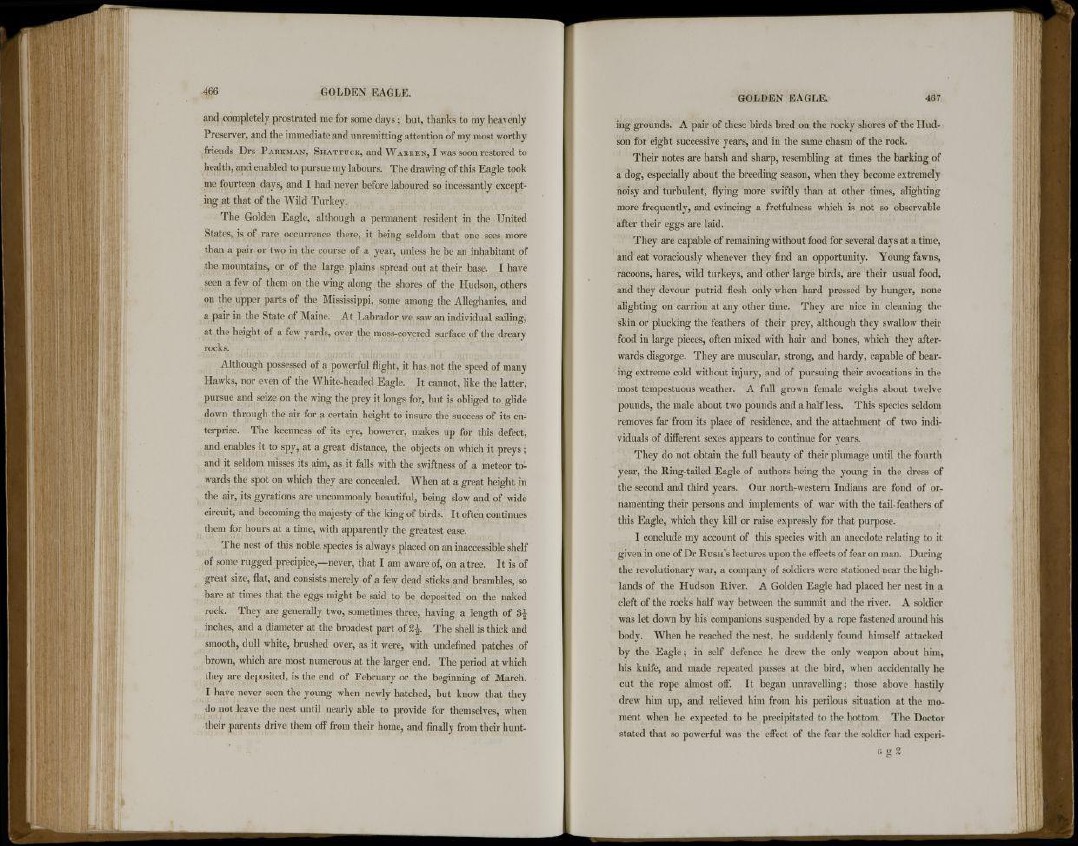
and completely prostrated me for some days; but, thanks to my heavenly
Preserver, and the immediate and unremitting attention of my most worthy
friends Drs PARKMAN, SHATTUCK, and WARREN, I was soon restored to
health, and enabled to pursue my labours. The drawing of this Eagle took
me fourteen days, and I had never before laboured so incessantly excepting
at that of the Wild Turkey.
The Golden Eagle, although a permanent resident in the United
States, is of rare occurrence there, it being seldom that one sees more
than a pair or two in the course of a year, unless he be an inhabitant of
the mountains, or of the large plains spread out at their base. I have
seen a few of them on the wing along the shores of the Hudson, others
on the upper parts of the Mississippi, some among the Alleghanies, and
a pair in the State of Maine. At Labrador we saw an individual sailing,
at the height of a few yards, over the moss-covered surface of the dreary
i9jl& Y ® T K l I f lW (89110(7 JiflK TtBIl flJlW JJ'JALUI QyJlO X)l«,
r
rocks.
Although possessed of a powerful flight, it has not the speed of many
Hawks, nor even of the White-headed Eagle. It cannot, like the latter,
pursue and seize on the wing the prey it longs for, but is obliged to glide
down through the air for a certain height to insure the success of its enterprise.
The keenness of its eye, however, makes up for this defect,
and enables it to spy, at a great distance, the objects on which it preys;
and it seldom misses its aim, as it falls with the swiftness of a meteor towards
the spot on which they are concealed. When at a great height in
the air, its gyrations are uncommonly beautiful, being slow and of Avide
circuit, and becoming the majesty of the king of birds. It often continues
them for hours at a time, with apparently the greatest ease.
The nest of this noble species is always placed on an inaccessible shelf
of some rugged precipice,—never, that I am aware of, on a tree. It is of
great size, flat, and consists merely of a few dead sticks and brambles, so
bare at times that the eggs might be said to be deposited on the naked
rock. They are generally two, sometimes three, having a length of 3^
inches, and a diameter at the broadest part of 2^. The shell is thick and
smooth, dull white, brushed over, as it were, with undefined patches of
brown, which are most numerous at the larger end. The period at which
they are deposited, is the end of February or the beginning of March.
I have never seen the young when newly hatched, but know that they
do not leave the nest until nearly able to provide for themselves, when
their parents drive them off from their home, and finally from their hunt-
GOLDEN EAGLE. 467
ing grounds. A pair of these birds bred on the rocky shores of the Hudson
for eight successive years, and in the same chasm of the rock.
Their notes are harsh and sharp, resembling at times the barking of
a dog, especially about the breeding season, when they become extremely
noisy and turbulent, flying more swiftly than at other times, alighting
more frequently, and evincing a fretfulness which is not so observable
after their eggs are laid.
They are capable of remaining without food for several days at a time,
and eat voraciously whenever they find an opportunity. Young fawns,
racoons, hares, wild turkeys, and other large birds, are their usual food,
and they devour putrid flesh only when hard pressed by hunger, none
alighting on carrion at any other time. They are nice in cleaning the
skin or plucking the feathers of their prey, although they swallow their
food in large pieces, often mixed with hair and bones, which they afterwards
disgorge. They are muscular, strong, and hardy, capable of bearing
extreme cold without injury, and of pursuing their avocations in the
most tempestuous weather. A full grown female weighs about twelve
pounds, the male about two pounds and a half less. This species seldom
removes far from its place of residence, and the attachment of two individuals
of different sexes appears to continue for years.
They do not obtain the full beauty of their plumage until the fourth
year, the Ring-tailed Eagle of authors being the young in the dress of
the second and third years. Our north-western Indians are fond of ornamenting
their persons and implements of war with the tail-feathers of
this Eagle, which they kill or raise expressly for that purpose.
I conclude my account of this species with an anecdote relating to it
given in one of Dr RUSH'S lectures upon the effects of fear on man. During
the revolutionary war, a company of soldiers were stationed near the highlands
of the Hudson River. A Golden Eagle had placed her nest in a
cleft of the rocks half way between the summit and the river. A soldier
was let down by his companions suspended by a rope fastened around his
body. When he reached the nest, he suddenly found himself attacked
by the Eagle; in self defence he drew the only weapon about him,
his knife, and made repeated passes at the bird, when accidentally he
cut the rope almost off. It began unravelling; those above hastily
drew him up, and relieved him from his perilous situation at the moment
when he expected to be precipitated to the bottom. The Doctor
stated that so powerful was the effect of the fear the soldier had experi-
G g 2